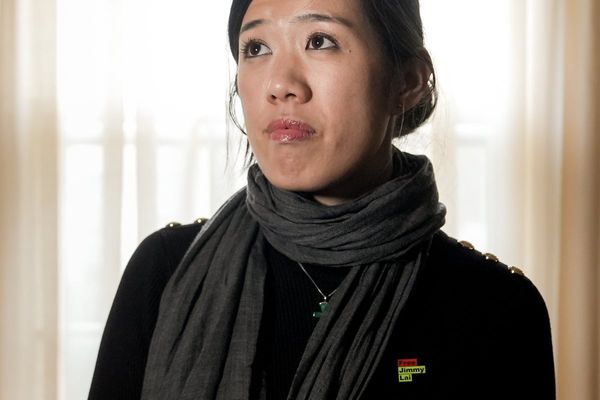
‘Do you know how much I could deadlift in my 50s? Guess!” Twyla Tharp implored Wayne McGregor, in a post-show interview at the Venice Dance Biennale. McGregor, the festival’s artistic director, didn’t dare venture a figure. “Two-hundred and twenty-seven pounds!” she told us all, delightedly.
Never underestimate Twyla. The slight, white-haired 84-year-old is as sharp as ever, and a force in the dance world. She’s been choreographing for 60 years, for ballet companies and Broadway, dance both experimental and accessible, art and pop. And she is honoured this year with the biennale’s Golden Lion for lifetime achievement.
Tharp is a smart, no-nonsense woman with a dry sense of humour, and her work is much the same. Only two pieces from her vast repertoire are staged in Venice this year, but one especially, Diabelli (from 1998), set to Beethoven’s 33 Diabelli Variations, has the same precise, self-certain manner as the woman herself. It takes one idea – the rigorous exploration of music and form – and drills into it determinedly. The dance is non-stop, a showcase for the tremendous dancers of her company, all quite different bodies but brilliant technicians, rooted in classicism with Tharp’s easy synthesis of jazz, contemporary and vernacular dance forms. It is absolutely chock-full of steps. That might seem obvious, but a lot of contemporary dance now hinges on vibe, mood and repetitive riffs, whereas Tharp is just step after step, finely and deliberately wrought phrases in constant motion with absolute clarity. With its fairly unwavering tone, from the audience there’s perhaps not as much light and shade as Tharp herself sees – but she has no time for dawdling (there’s a similarity with McGregor’s own work here: the constant fast-paced flying mind, expecting you to keep up).
The second piece is the European premiere of Slacktide, set to Philip Glass. It’s new, but interestingly, uses material from Tharp’s back catalogue, reversioned. Compared with Diabelli, the look is certainly more “now”, diffused light, dancers in black shorts and vests, and rather than the front-facing performance mode of the earlier work, the dancers are on their own trajectories, moving between solos and groups. It has a greater sense of freedom, dynamic and edge, but the same very serious conversation with choreography.
The winner of the Silver Lion, for an outstanding upcoming choreographer, was the Brazilian Carolina Bianchi. Bianchi has the same absolute commitment to her art as Tharp, but is a completely different proposition. She’s best known for the first part of her Cadela Força trilogy, The Bride and the Goodnight Cinderella, in which Bianchi takes a date rape drug live on stage and then attempts to continue the show while the audience watch its effects take over, made in response to her own experience of sexual assault.
The second chapter of the trilogy, The Brotherhood, gets its Italian premiere in Venice and it goes deeper (very much deeper, at almost four hours in length) into Bianchi’s own attempts to process what happened to her: the injustice, the omnipresent patriarchy, the bewilderment over what gives men seeming licence to abuse women, from the rape of Lucretia to Gisèle Pelicot. She does this through film, performance, a faux interview with a famous theatre director, set-pieces with the male performers from company Cara de Cavalo, and addressing the audience directly. She considers hazing initiations, the myth of the troubled genius in art, the politics of the rehearsal room, the subtle undermining of women in professional life. There’s so much here, a bit of editing wouldn’t go amiss (although it doesn’t feel like 220 minutes) but then this is the ever-circling mind after trauma, always returning to the wound, never finding the answer.
Fearless Bianchi is sometimes provocatively shocking, she is also constantly questioning herself, getting in her criticisms before anyone else can. Her subjects are theatre, art, violence and anger. And the real question may be, why aren’t we all angrier, all the time, about how commonplace this abuse is? Bianchi introduces herself on stage as predominantly a writer, and this is a text-based show within the realm of performance art, an interesting choice for a dance prize. But the body is absolutely at the centre of her work. Her central question, as she puts it, is what do we do with this body? How to live in a body that survives rape?
Elsewhere at the biennale, the opening show comes from Australia’s Chunky Move, a company established in 1995, now led by Antony Hamilton, who has choreographed U>N>I>T>E>D. The stage is dominated by a large mechanical contraption, a piece of rigging that holds what looks like a giant insect with flashing and glowing lights. The dancers have mechanical limbs too, multijointed insect-y legs attached to them, turning them into human-machine hybrid hexapods.
It immediately brought to mind a piece McGregor made for his company in 2002, Nemesis, where the dancers wore mechanical limbs extending their arms. In fact the whole look is very millennium-bug-throwback, like a guerrilla army of hackers who’ve jumped the fence at Glastonbury, in baggy parachute pants with all sorts of straps and layers and clashing patterns and camo and reflective neon. It’s a crusty-cyberpunk look – if you ever went near Brighton in the 1990s, you’d recognise it. Except that in the 90s we barely had mobile phones or email addresses and this kind of tech felt like pure sci-fi, whereas now, the idea of humans getting tech implants or machines becoming sentient is basically the world we live in. So that’s unnerving. But what does Hamilton have to say about it? Not so much. The thing about all the cumbersome props is that they extend the body’s possibilities, but also reduce their ability to move. There’s a vague sense of struggle between embracing or fighting the machines but, just like in the real world, having the technology is one thing, deciding what to use it for, or what you want to say with it, is entirely another. It’s neither stirringly hopeful nor apocalyptic enough to be terrifying. Twyla would have those mechanical critters for breakfast.
• The Venice Dance Biennale continues until 2 August. This trip was paid for by the Venice Biennale.







